![[*]](http://sepwww.stanford.edu/latex2html/cross_ref_motif.gif) shows the velocity model with the
coordinate system overlayed.
Figure
shows the velocity model with the
coordinate system overlayed.
Figure ![[*]](http://sepwww.stanford.edu/latex2html/cross_ref_motif.gif) shows the coordinate system coefficients
defined in equation (9).
shows the coordinate system coefficients
defined in equation (9).
The first example is based on a model with two smooth velocity
anomalies that generate focusing and defocussing of the coordinate
system, without triplication.
I construct the coordinate system by ray tracing from
an incident horizontal plane-wave at the surface.
Figure ![[*]](http://sepwww.stanford.edu/latex2html/cross_ref_motif.gif) shows the velocity model with the
coordinate system overlayed.
Figure
shows the velocity model with the
coordinate system overlayed.
Figure ![[*]](http://sepwww.stanford.edu/latex2html/cross_ref_motif.gif) shows the coordinate system coefficients
defined in equation (9).
shows the coordinate system coefficients
defined in equation (9).
|
RWEimp0.cos
Figure 1 Velocity map and Riemannian coordinate system. | 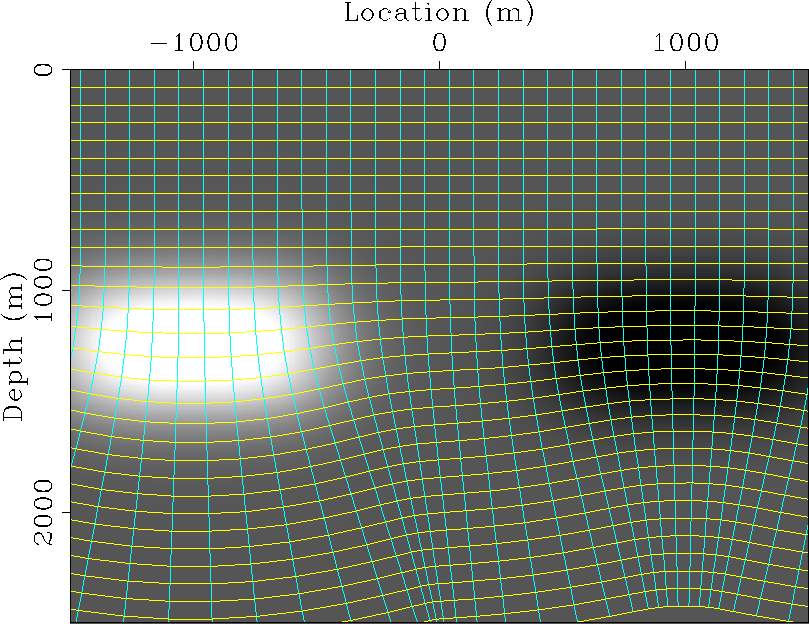 |
The goal of this test model is to illustrate the higher-order extrapolation
kernels in a fairly simple coordinate system
which is close to a Cartesian basis.
The coordinate system is constructed from an
incident plane wave, while the data comes from a point source.
This setting is almost identical to the case of extrapolation
from a point source in Cartesian coordinates,
where high-angle
![[*]](http://sepwww.stanford.edu/latex2html/foot_motif.gif) propagation requires high-order kernels.
In this case, the Riemannian coordinate system does not match closely the
general direction of wave propagation, so higher order kernels are needed.
In practice, this situation can be addressed better with
synthesized plane-wave data extrapolated in a coordinate system
ray traced from an incident plane, and with point source data
extrapolated in a coordinate system ray traced from a point source.
propagation requires high-order kernels.
In this case, the Riemannian coordinate system does not match closely the
general direction of wave propagation, so higher order kernels are needed.
In practice, this situation can be addressed better with
synthesized plane-wave data extrapolated in a coordinate system
ray traced from an incident plane, and with point source data
extrapolated in a coordinate system ray traced from a point source.
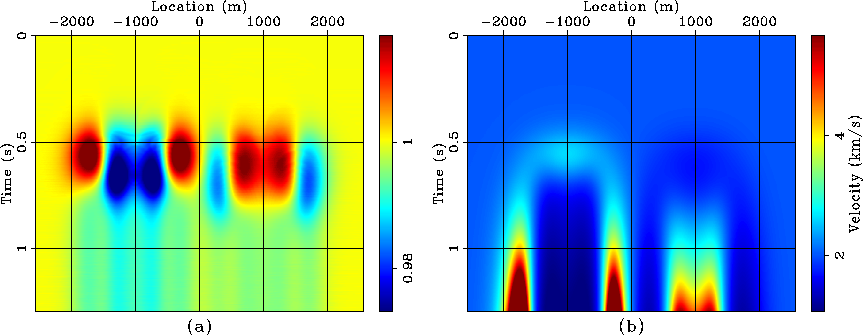 |
![[*]](http://sepwww.stanford.edu/latex2html/movie.gif)
Figure ![[*]](http://sepwww.stanford.edu/latex2html/cross_ref_motif.gif) shows the velocity model and
impulse responses for a point source
computed with various extrapolators in
ray coordinates (
shows the velocity model and
impulse responses for a point source
computed with various extrapolators in
ray coordinates (![]() and
and ![]() ).
Panel (a) shows the slowness model,
panel (b) shows extrapolation with the
).
Panel (a) shows the slowness model,
panel (b) shows extrapolation with the ![]() finite-differences equation,
panel (c) shows extrapolation with the
finite-differences equation,
panel (c) shows extrapolation with the ![]() finite-differences equation,
panel (d) shows extrapolation with the split-step Fourier (SSF) equation,
panel (e) shows extrapolation with the pseudo-screen (PSC) equation, and
panel (f) shows extrapolation with the Fourier finite-differences (FFD) equation.
All plots are displayed in ray coordinates.
We can observe that the angular accuracy of the extrapolator
improves for the more accurate extrapolators.
The finite-differences solutions (panels b and c) show the typical
behavior of such solutions for the
finite-differences equation,
panel (d) shows extrapolation with the split-step Fourier (SSF) equation,
panel (e) shows extrapolation with the pseudo-screen (PSC) equation, and
panel (f) shows extrapolation with the Fourier finite-differences (FFD) equation.
All plots are displayed in ray coordinates.
We can observe that the angular accuracy of the extrapolator
improves for the more accurate extrapolators.
The finite-differences solutions (panels b and c) show the typical
behavior of such solutions for the ![]() and
and ![]() equations
(e.g. the cardioid for
equations
(e.g. the cardioid for ![]() ), but in the more
general setting of Riemannian extrapolation.
The mixed-domain extrapolators (panels d, e, and f) show increased
accuracy. The main differences occur at the highest propagation
angles, and the most accurate extrapolators of those compared
is the equivalent of Fourier finite-differences (panel f).
), but in the more
general setting of Riemannian extrapolation.
The mixed-domain extrapolators (panels d, e, and f) show increased
accuracy. The main differences occur at the highest propagation
angles, and the most accurate extrapolators of those compared
is the equivalent of Fourier finite-differences (panel f).
Figure ![[*]](http://sepwww.stanford.edu/latex2html/cross_ref_motif.gif) shows the corresponding plots in
Figure
shows the corresponding plots in
Figure ![[*]](http://sepwww.stanford.edu/latex2html/cross_ref_motif.gif) mapped in the physical coordinates,
except for panel (a) which in this case shows the impulse
response for extrapolation in Cartesian coordinates using
a Fourier finite-differences extrapolator with a
mapped in the physical coordinates,
except for panel (a) which in this case shows the impulse
response for extrapolation in Cartesian coordinates using
a Fourier finite-differences extrapolator with a
![]() finite-differences term.
The overlay is an outline of the extrapolation coordinate system.
After re-mapping to the physical space, the comparison of
high-angle accuracy for the various extrapolators is more obvious,
since it now has the proper physical meaning.
finite-differences term.
The overlay is an outline of the extrapolation coordinate system.
After re-mapping to the physical space, the comparison of
high-angle accuracy for the various extrapolators is more obvious,
since it now has the proper physical meaning.
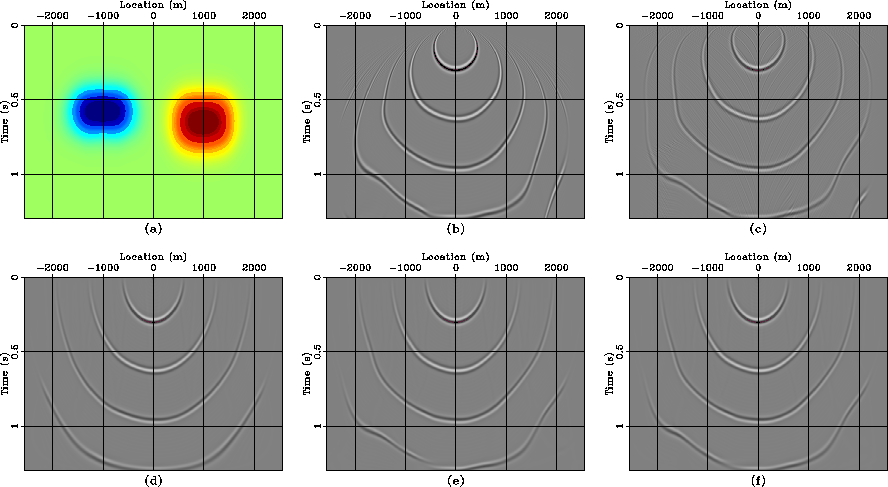 |
![[*]](http://sepwww.stanford.edu/latex2html/movie.gif)
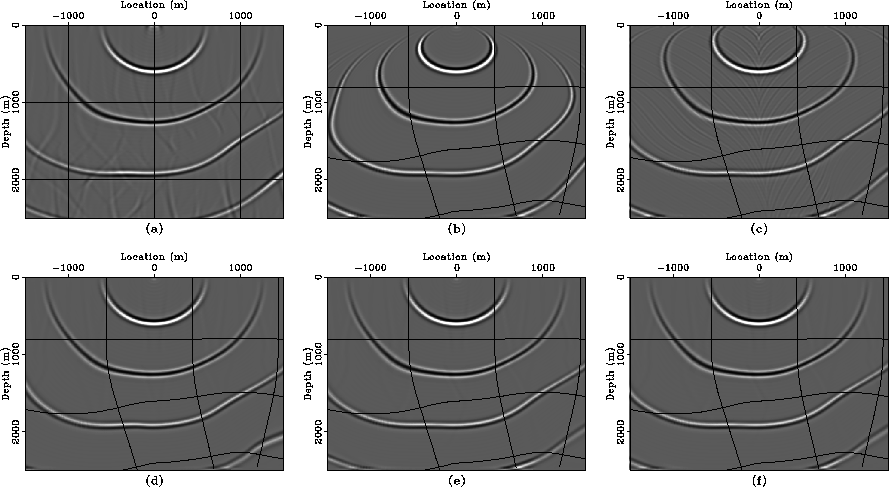 |
![[*]](http://sepwww.stanford.edu/latex2html/movie.gif)
The second example is based on a model with a large lateral
gradient which makes an incident plane wave overturn.
A small Gaussian anomaly forces the coordinate system to focus
slightly, and another large Gaussian anomaly, not used for the
coordinate system, forces the propagating wave to triplicate
and move at high angles relative to the extrapolation direction.
Figure ![[*]](http://sepwww.stanford.edu/latex2html/cross_ref_motif.gif) shows the velocity model with the
coordinate system overlayed.
Figure
shows the velocity model with the
coordinate system overlayed.
Figure ![[*]](http://sepwww.stanford.edu/latex2html/cross_ref_motif.gif) shows the coordinate system coefficients
defined in equation (9).
shows the coordinate system coefficients
defined in equation (9).
|
RWEimp1.cos
Figure 5 Velocity map and Riemannian coordinate system. | 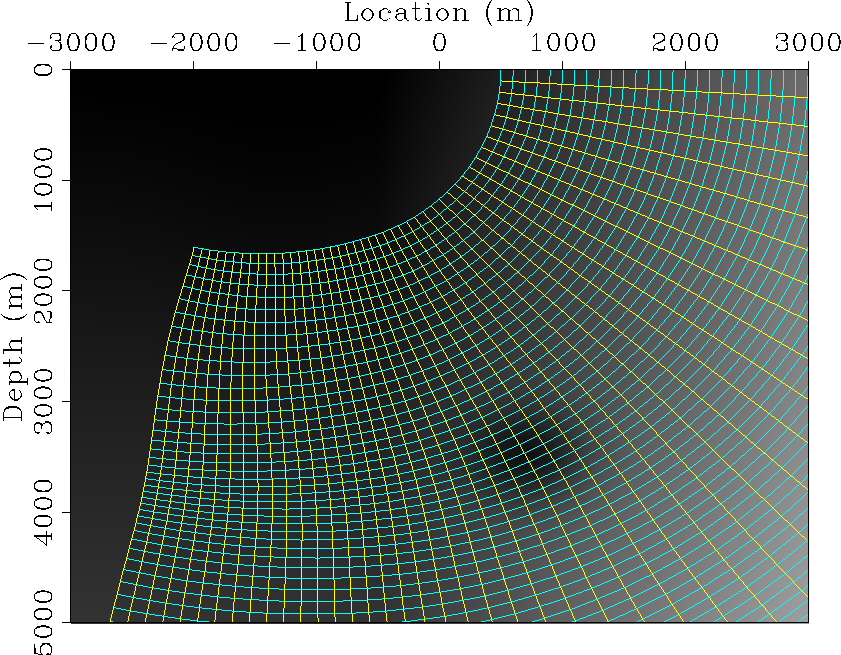 |
The goal of this model is to illustrate Riemannian wavefield
extrapolation in a situation which cannot be handled correctly
by Cartesian extrapolation, no matter how accurate.
In this example, an incident plane wave is overturning, thus
becoming evanescent for the solution in Cartesian coordinates.
Furthermore, the large Gaussian anomaly, Figure ![[*]](http://sepwww.stanford.edu/latex2html/cross_ref_motif.gif) (a),
causes serious wavefield triplication, thus requiring
high-order kernels in the Riemannian extrapolator.
(a),
causes serious wavefield triplication, thus requiring
high-order kernels in the Riemannian extrapolator.
Figure ![[*]](http://sepwww.stanford.edu/latex2html/cross_ref_motif.gif) shows the velocity model and
impulse responses for an incident plane wave
computed with various extrapolators in
ray coordinates (
shows the velocity model and
impulse responses for an incident plane wave
computed with various extrapolators in
ray coordinates (![]() and
and ![]() ).
Panel (a) shows the slowness model,
panel (b) shows extrapolation with the
).
Panel (a) shows the slowness model,
panel (b) shows extrapolation with the ![]() finite-differences equation,
panel (c) shows extrapolation with the
finite-differences equation,
panel (c) shows extrapolation with the ![]() finite-differences equation,
panel (d) shows extrapolation with the split-step Fourier (SSF) equation,
panel (e) shows extrapolation with the pseudo-screen (PSC) equation, and
panel (f) shows extrapolation with the Fourier finite-differences (FFD) equation.
All plots are displayed in ray coordinates.
As with the preceding example, we can observe increased angular accuracy
as we increase the order of the extrapolator. The equivalent FFD is the
most accurate.
finite-differences equation,
panel (d) shows extrapolation with the split-step Fourier (SSF) equation,
panel (e) shows extrapolation with the pseudo-screen (PSC) equation, and
panel (f) shows extrapolation with the Fourier finite-differences (FFD) equation.
All plots are displayed in ray coordinates.
As with the preceding example, we can observe increased angular accuracy
as we increase the order of the extrapolator. The equivalent FFD is the
most accurate.
As in the preceding example,
Figure ![[*]](http://sepwww.stanford.edu/latex2html/cross_ref_motif.gif) shows the corresponding plots in
Figure
shows the corresponding plots in
Figure ![[*]](http://sepwww.stanford.edu/latex2html/cross_ref_motif.gif) mapped in the physical coordinates,
except for panel (a) which in this case shows the impulse
response for extrapolation in Cartesian coordinates using
a Fourier finite-differences extrapolator with a
mapped in the physical coordinates,
except for panel (a) which in this case shows the impulse
response for extrapolation in Cartesian coordinates using
a Fourier finite-differences extrapolator with a
![]() finite-differences term.
The overlay is an outline of the extrapolation coordinate system.
finite-differences term.
The overlay is an outline of the extrapolation coordinate system.
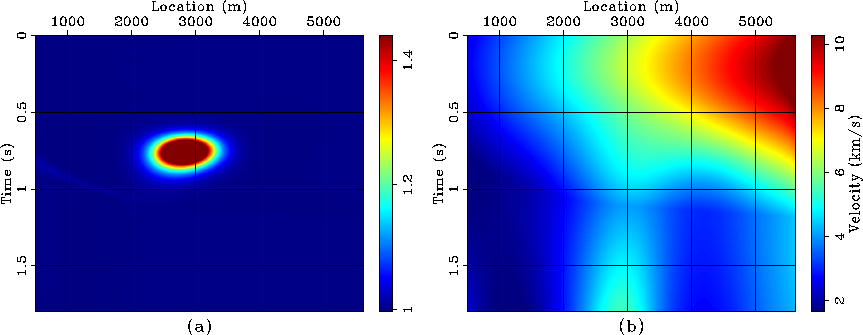 |
![[*]](http://sepwww.stanford.edu/latex2html/movie.gif)
Panel (a) in Figure ![[*]](http://sepwww.stanford.edu/latex2html/cross_ref_motif.gif) clearly shows the failure of
the Cartesian extrapolator in propagating waves correctly even up to
clearly shows the failure of
the Cartesian extrapolator in propagating waves correctly even up to
![]() . All Riemannian extrapolators handle better the
overturning waves, including energy that is propagating upward relative
to the physical coordinates. As expected, the higher order kernels
are more accurate in describing the triplicating wavefields.
. All Riemannian extrapolators handle better the
overturning waves, including energy that is propagating upward relative
to the physical coordinates. As expected, the higher order kernels
are more accurate in describing the triplicating wavefields.
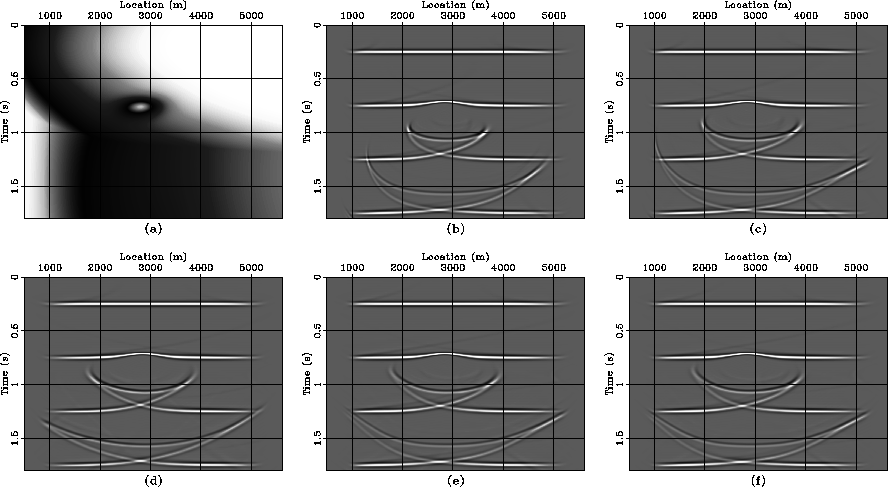 |
![[*]](http://sepwww.stanford.edu/latex2html/movie.gif)
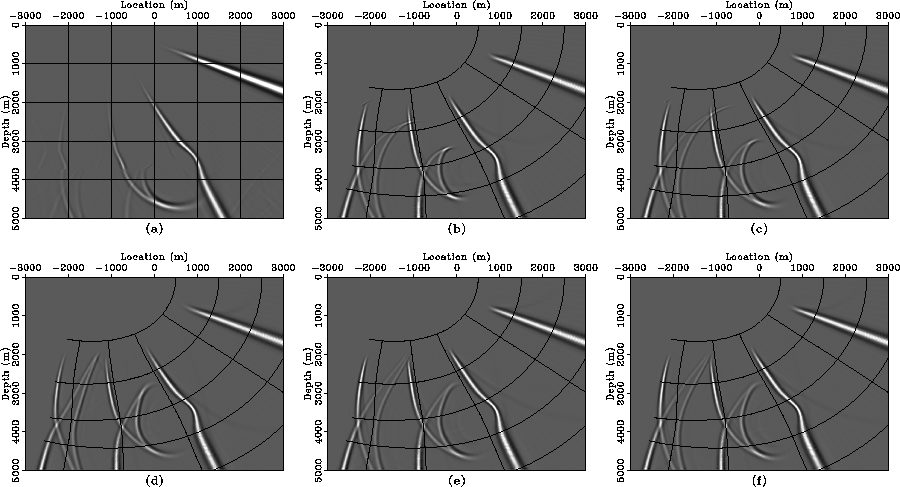 |
![[*]](http://sepwww.stanford.edu/latex2html/movie.gif)